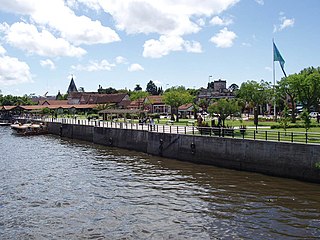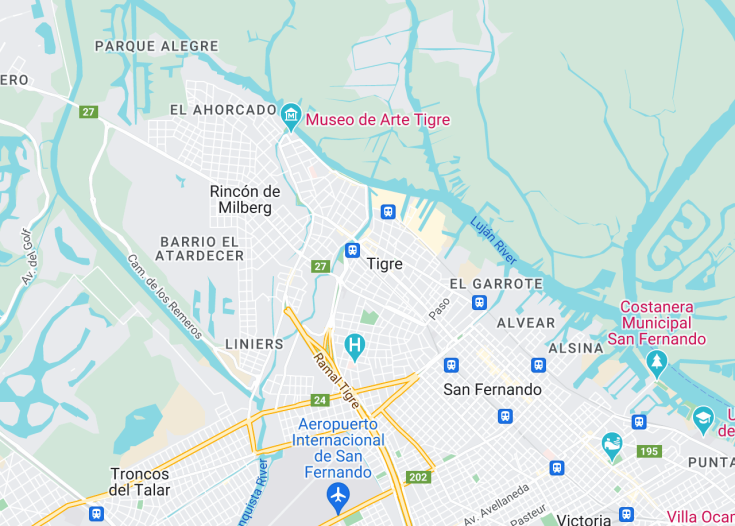Nestled in the lush delta of the Paraná River, Tigre stands as a serene escape just north of Buenos Aires, Argentina. Known for its idyllic riverside setting, this charming locale offers a unique blend of natural beauty, art, and culture. Visitors can explore the famed Puerto de Frutos, a lively market that sells regional crafts and foods, or enjoy boat tours along the myriad channels and streams. The Museo de Arte de Tigre, housed in an opulent belle-époque casino, showcases splendid local art, making Tigre an exquisite fusion of nature and human creativity.
To enjoy Tigre to the fullest, consider taking a boat tour early in the morning when the river is most tranquil and the wildlife, including diverse bird species, is more active.
Don’t miss a visit to the Museo de Arte de Tigre, where you can delve into Argentina’s vibrant art scene within a breathtaking architectural setting.
Tigre: The Delta’s Gate
| Country | Argentina |
| Time in Tigre | GMT-3 |
| Language spoken | Spanish |
| Population | 31,106 (2020 Census – INDEC) |
| Currency | Argentine Peso (ARS $) |
| Airports |
|
Tigre, a quaint city nestled in the sprawling delta of the Paraná River in Buenos Aires Province, Argentina, has long captured the hearts of travelers and locals alike. Known for its idyllic scenery, Tigre offers a tranquil escape from the bustling life of nearby Buenos Aires, situated just 28 kilometers to the south. The city’s name, derived from the jaguars that were once hunted in the area, marks a rich history intertwined with the natural beauty of its surroundings.
Tigre’s robust tourist infrastructure is centered around the Puerto de Frutos, a vibrant market where artisans and vendors sell a range of local goods from homemade furniture and decorative items to fresh fruit and delicacies. The delta itself, with its network of rivers and streams, serves as a popular spot for boating, rowing, and other water sports, drawing outdoor enthusiasts year-round.
The city is also famous for the Museo de Arte Tigre, an impressive arts museum housed in an ornate building that was once a social club for Buenos Aires’ elite. This museum showcases a varied collection of Argentine art, reflecting the cultural heritage of the region. The area’s historical significance and artistic culture are also exemplified in the Tigre Club, a grand casino turned into a cultural museum.
Moreover, frequent cultural festivals and a bustling nightlife, coupled with the serene beauty of the delta, make Tigre a must-visit destination. Its small-town charm, enriched with cultural and recreational activities, invites tourists to immerse themselves in a unique part of Argentine culture and history, making every visit unforgettable.
Where is Tigre?
Located in the northeastern part of Buenos Aires Province, Tigre lies on the Delta of the Paraná River.
Distances:
| Route | Distance by car | Time by car |
|---|---|---|
| Buenos Aires to Tigre | 17 miles (28 km) | 40 minutes |
| La Plata to Tigre | 63 miles (102 km) | 1 hour 25 minutes |
What is Tigre famous for?
Tigre is renowned for its scenic delta where the Paraná River fans out into numerous streams, creating a labyrinth of islands making it ideal for boating and water sports. Its rich cultural scene, historic museums, and vibrant market only enhance its allure.
History
Pre-Columbian Period – Before 1580
The area now known as Tigre has been inhabited for thousands of years. The primary indigenous tribe, the Querandíes, lived along the Paraná Delta, thriving on fishing, hunting, and gathering. The name ‘Tigre’ itself likely originates from the ‘tigres’ or jaguars that once roamed the delta region.
Colonial Period – 1580 to 1810
The arrival of Spanish expeditions in the late 16th century marked a turning point for the region. In 1580, Juan de Garay, a Spanish conquistador, included the area in his jurisdiction when he founded Buenos Aires. However, Tigre remained largely uninhabited by European settlers due to its challenging marshy environment and the threat from the native populations.
Development of Tigre – 1820 to 1900
The 19th century brought significant changes as the area started to be developed for tourism and as a trading route, given its strategic position in the Delta. Small docks and storage facilities emerged, supporting the burgeoning fruit trade. By the late 1800s, with the introduction of the railway and increased river transport capabilities, Tigre became a popular weekend and holiday destination for residents of Buenos Aires.
20th Century – 1900 to 2000
The 20th century was a golden era for Tigre as it transformed into a bustling hub of culture and recreation. The iconic Tigre Club, opened in 1912, epitomized this era, showcasing an opulent casino and a social center that attracted the elite of Argentine society. Despite the club’s closure in the 1940s, Tigre retained its charm with its riverside attractions, museums, and parks.
Modern Day – 2000 to Present
Today, Tigre is recognized for its blend of historic architecture, artistic venues, and natural beauty. The city has embraced modern tourism without losing the essence of its historical roots, evidenced by the restoration of the Tigre Art Museum, formerly the Tigre Club, and the continued popularity of the Puerto de Frutos, a bustling local market with deep historical significance.
Visit Tigre
What to see and do in Tigre, Argentina
Tigre offers a diverse range of attractions and activities that cater to all tastes:
- Explore the Puerto de Frutos, a market known for local handicrafts and regional produce.
- Visit the Tigre Art Museum to see impressive collections housed in an elegant belle époque building.
- Take a boat tour of the Paraná Delta to experience its unique flora and fauna up close.
- Stroll along the Paseo Victorica, a picturesque riverside walk dotted with historical buildings and cafes.
- For thrill-seekers, Parque de la Costa offers exciting rides and entertainment.
Festivals and Events in Tigre
Tigre hosts several cultural and recreational events year-round. Highlights include the Maté Festival, celebrating Argentina’s traditional drink each November, and the Tigre Art Festival in June, where local and international artists display their work. Seasonal boat parades and regattas also add to the city’s vibrant calendar.
Best time to visit Tigre
The ideal time to visit Tigre is during spring (September to November) and autumn (March to May). These months offer mild temperatures and less humidity, making it perfect for outdoor activities and exploring the delta.
Is Tigre worth visiting?
Tigre is undoubtedly worth a visit. With its rich blend of cultural heritage, natural beauty, and vibrant local life, it offers something unique for every visitor. Whether you’re interested in exploring the serene landscapes of the Paraná Delta, indulging in local crafts and cuisine, or simply enjoying a leisurely day out, Tigre provides a charming escape from the bustle of Buenos Aires.









